2015 HONDA CROSSTOUR weight
[x] Cancel search: weightPage 416 of 573

415Continued
Driving
Towing a Trailer
Towing Preparation
Your vehicle can tow a trailer if you carefully observe the load limits, use the proper
equipment, and follow the towing guidelin es. Check the load limits before driving.
■Total trailer weight
Maximum allowable weight of the trailer,
cargo, and everything in or on it must not
exceed 1,500 lbs (680 kg) for 6-cylinder
models and 1,000 lbs (453 kg) for 4-cylinder
models. Towing loads in excess of this can
seriously affect vehicle handling and
performance and can damage the engine and
drivetrain.
■Tongue load
The weight of the tongue with a fully loaded
trailer on the hitch should be approximately
10% of the total trailer weight.
• Excessive tongue load reduces front tire
traction and steering control. Too little
tongue load can make the trailer unstable
and cause it to sway.
• To achieve a proper tongue load, start by
loading 60% of the load toward the front
of the trailer and 40% toward the rear.
Readjust the lo ad as needed.
■Towing Load Limits1Towing Load Limits
Check if all loads are within limits at a public scale.
If a public scale is not available, add the estimated
weight of your cargo load to the weight of your
trailer (as quoted by th e manufacturer), and the
tongue load.
Break-in Period
Avoid towing a trailer duri ng your vehicle’s first 600
miles (1,000 km).
Never exceed the gross weight ratings.
Gross weight information 2 Vehicle Specifications P. 546, 548
3WARNING
Exceeding any load limit or improperly
loading your vehicle and trailer can cause a
crash in which you can be seriously hurt or
killed.
Check the loading of your vehicle and
trailer carefully before starting to drive.
Total Load
To ngue LoadTongue Load
15 CROSSTOUR-31TP66500.book 415 ページ 2014年7月31日 木曜日 午後3時23分
Page 419 of 573
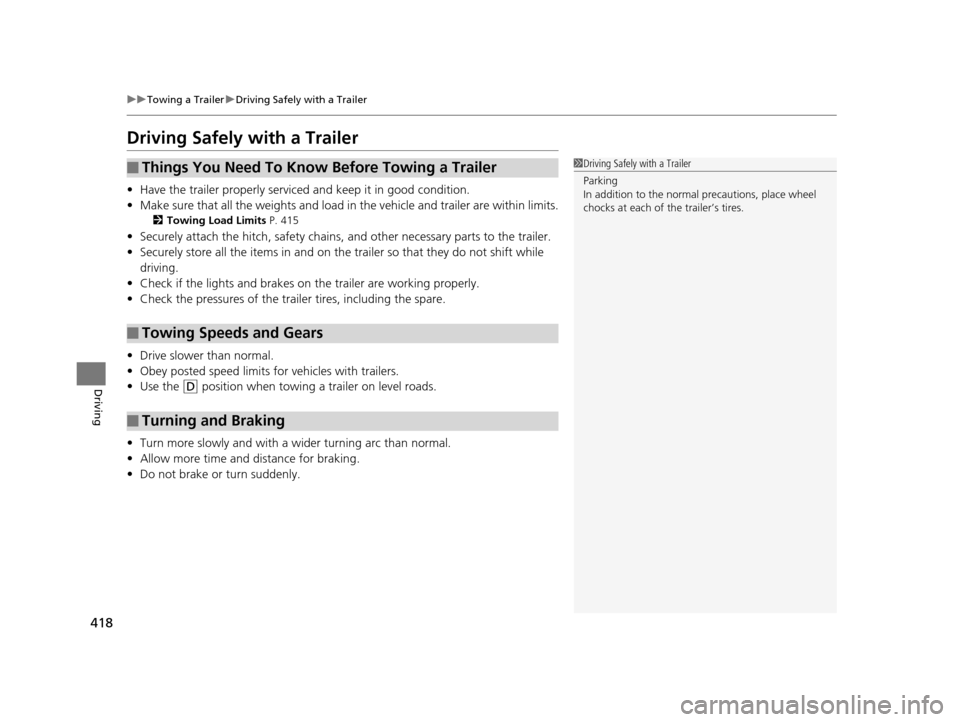
418
uuTowing a Trailer uDriving Safely with a Trailer
Driving
Driving Safely with a Trailer
• Have the trailer properly serviced and keep it in good condition.
• Make sure that all the weights and load in the vehicle and trailer are within limits.
2Towing Load Limits P. 415
•Securely attach the hitch, safety chains, and other necessary parts to the trailer.
• Securely store all the items in and on the trailer so that they do not shift while
driving.
• Check if the lights and brakes on the trailer are working properly.
• Check the pressures of the traile r tires, including the spare.
• Drive slower than normal.
• Obey posted speed limits for vehicles with trailers.
• Use the
(D position when towing a trailer on level roads.
• Turn more slowly and with a wider turning arc than normal.
• Allow more time and distance for braking.
• Do not brake or turn suddenly.
■Things You Need To Know Before Towing a Trailer
■Towing Speeds and Gears
■Turning and Braking
1Driving Safely with a Trailer
Parking
In addition to the normal precautions, place wheel
chocks at each of the trailer’s tires.
15 CROSSTOUR-31TP66500.book 418 ページ 2014年7月31日 木曜日 午後3時23分
Page 460 of 573
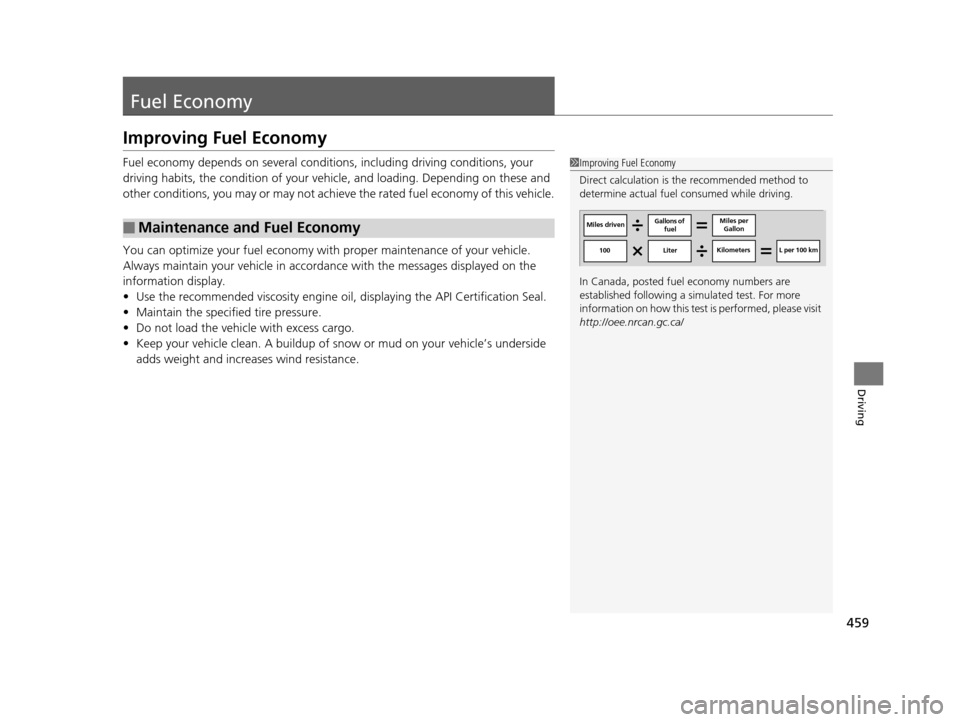
459
Driving
Fuel Economy
Improving Fuel Economy
Fuel economy depends on several conditions, including driving conditions, your
driving habits, the condition of your vehicle, and loading. Depending on these and
other conditions, you may or may not achieve the rated fuel economy of this vehicle.
You can optimize your fuel economy with proper maintenance of your vehicle.
Always maintain your vehicle in accordance with the messages displayed on the
information display.
• Use the recommended viscosit y engine oil, displaying the API Certification Seal.
• Maintain the specified tire pressure.
• Do not load the vehicle with excess cargo.
• Keep your vehicle clean. A buildup of snow or mud on your vehicle’s underside
adds weight and increases wind resistance.
■Maintenance and Fuel Economy
1Improving Fuel Economy
Direct calculation is the recommended method to
determine actual fuel consumed while driving.
In Canada, posted fuel economy numbers are
established following a simulated test. For more
information on how this test is performed, please visit
http://oee.nrcan.gc.ca/
Miles driven Gallons of
fuel Miles per
Gallon
100 LiterKilometers L per 100 km
15 CROSSTOUR-31TP66500.book 459 ページ 2014年7月31日 木曜日 午後3時23分
Page 499 of 573
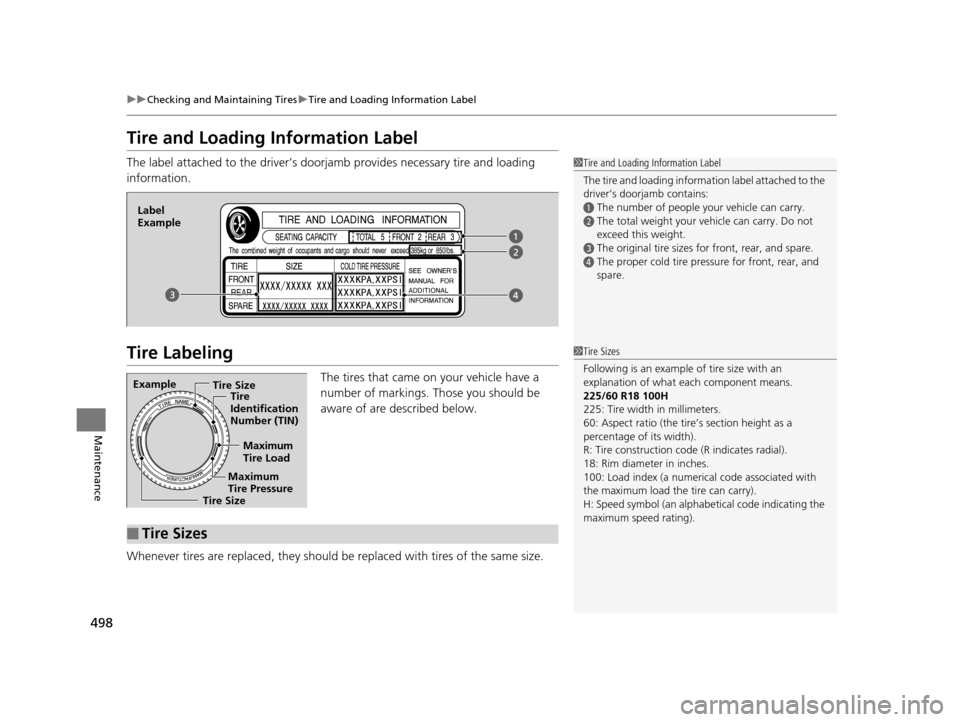
498
uuChecking and Maintaining Tires uTire and Loading Information Label
Maintenance
Tire and Loading Information Label
The label attached to the driver’s doorj amb provides necessary tire and loading
information.
Tire Labeling
The tires that came on your vehicle have a
number of markings. Those you should be
aware of are described below.
Whenever tires are replaced, they should be replaced with tires of the same size.
1 Tire and Loading Information Label
The tire and loading informat ion label attached to the
driver’s doorjamb contains:
aThe number of people your vehicle can carry.
bThe total weight your vehicle can carry. Do not
exceed this weight.
cThe original tire sizes for front, rear, and spare.
dThe proper cold tire pre ssure for front, rear, and
spare.
Label
Example
Example Tire Size
Tire
Identification
Number (TIN)
Maximum
Tire Load
Maximum
Tire Pressure
Tire Size
■Tire Sizes
1 Tire Sizes
Following is an example of tire size with an
explanation of what each component means.
225/60 R18 100H
225: Tire width in millimeters.
60: Aspect ratio (the tire’s section height as a
percentage of its width).
R: Tire construction code (R indicates radial).
18: Rim diameter in inches.
100: Load index (a numerical code associated with
the maximum load the tire can carry).
H: Speed symbol (an alphabe tical code indicating the
maximum speed rating).
15 CROSSTOUR-31TP66500.book 498 ページ 2014年7月31日 木曜日 午後3時23分
Page 522 of 573

Continued521
uuIf a Tire Goes Flat uChanging a Flat Tire
Handling the Unexpected
1. Place the jack under the jacking point
closest to the tire to be changed.
2. Turn the end bracket (as shown in the
image) clockwise until the top of the jack
contacts the jacking point.
u Make sure that the jacking point tab is
resting in the jack notch.
3. Raise the vehicle, using the jack handle bar
and the jack handle, until the tire is off the
ground.
■How to Set Up the Jack1How to Set Up the Jack
Do not use the jack with people or luggage in the
vehicle.
Use the jack provided in your vehicle.
Other jacks may not support the weight (“load”) or
their shape may not match.
The following instructions must be followed to use
the jack safely.
•Do not use while the engine is running.
•Use only where the ground is firm and level.
•Use only at the jacking points.•Do not get in the vehicl e while using the jack.
•Do not put anything on top of or underneath the
jack.
3WARNING
The vehicle can easily roll off the jack,
seriously injuring anyone underneath.
Follow the directions for changing a tire
exactly, and never get under the vehicle
when it is supported only by the jack.
Jack
Handle
Bar Wheel Nut
Wrench as Jack Handle
15 CROSSTOUR-31TP66500.book 521 ページ 2014年7月31日 木曜日 午後3時23分
Page 543 of 573
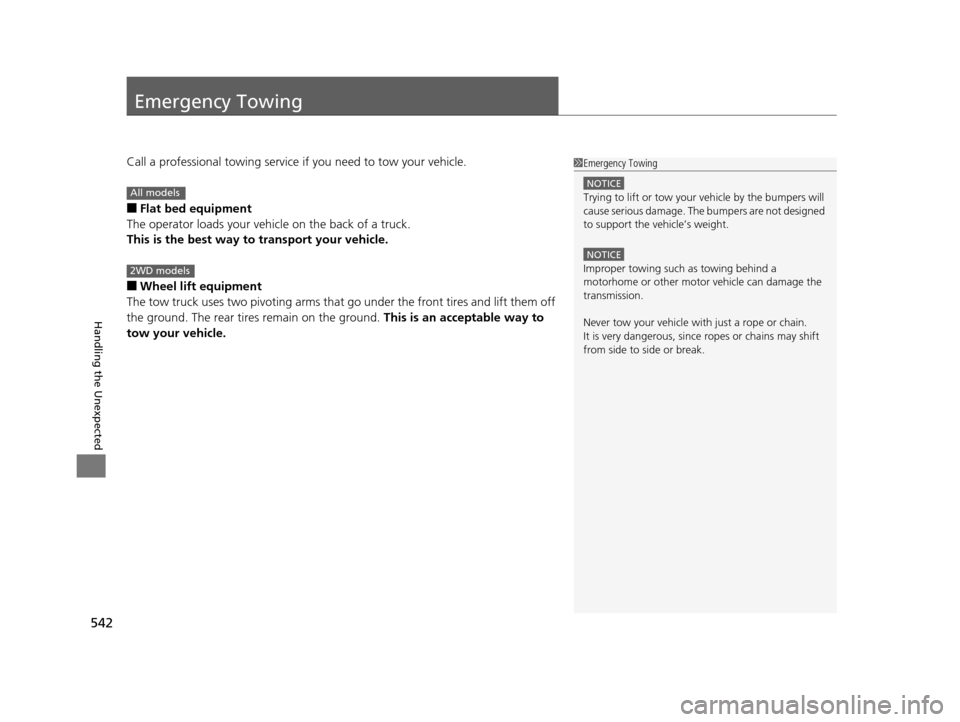
542
Handling the Unexpected
Emergency Towing
Call a professional towing service if you need to tow your vehicle.
■Flat bed equipment
The operator loads your vehicle on the back of a truck.
This is the best way to transport your vehicle.
■Wheel lift equipment
The tow truck uses two pivoti ng arms that go under the front tires and lift them off
the ground. The rear tires remain on the ground. This is an acceptable way to
tow your vehicle.
1 Emergency Towing
NOTICE
Trying to lift or tow your vehicle by the bumpers will
cause serious damage. The bumpers are not designed
to support the vehicle’s weight.
NOTICE
Improper towing such as towing behind a
motorhome or other motor vehicle can damage the
transmission.
Never tow your vehicle with just a rope or chain.
It is very dangerous, since ropes or chains may shift
from side to side or break.
All models
2WD models
15 CROSSTOUR-31TP66500.book 542 ページ 2014年7月31日 木曜日 午後3時23分
Page 547 of 573
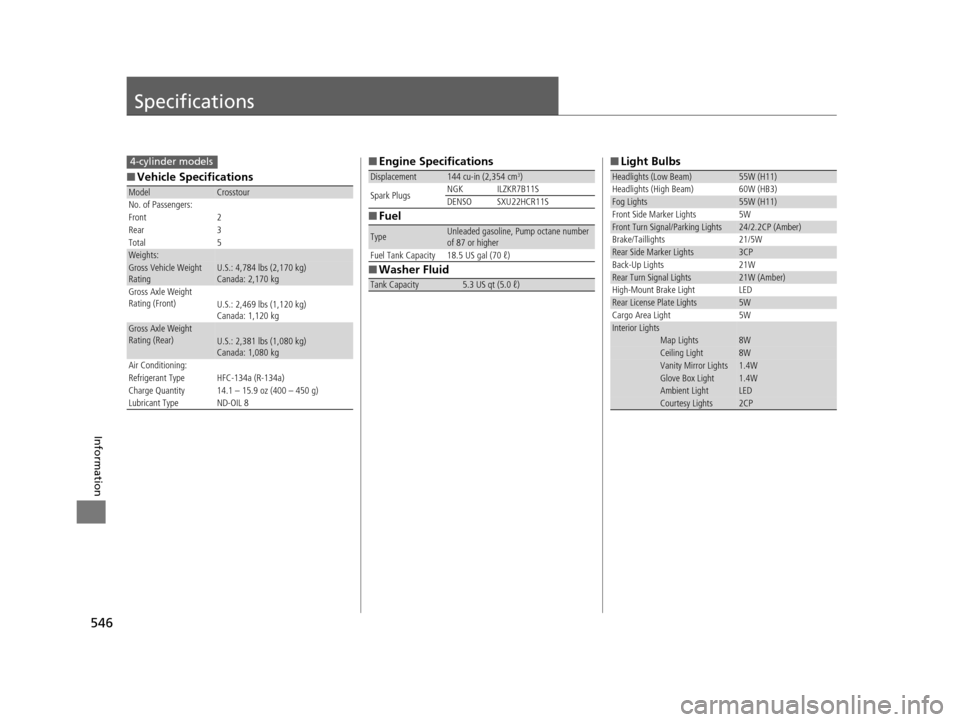
546
Information
Specifications
■Vehicle Specifications
ModelCrosstour
No. of Passengers:
Front 2
Rear 3
Total 5
Weights:Gross Vehicle Weight
Rating U.S.: 4,784 lbs (2,170 kg)
Canada: 2,170 kg
Gross Axle Weight
Rating (Front)U.S.: 2,469 lbs (1,120 kg)
Canada: 1,120 kg
Gross Axle Weight
Rating (Rear)U.S.: 2,381 lbs (1,080 kg)
Canada: 1,080 kg
Air Conditioning:
Refrigerant Type HFC-134a (R-134a)
Charge Quantity 14.1 – 15.9 oz (400 – 450 g)
Lubricant Type ND-OIL 8
4-cylinder models■ Engine Specifications
■ Fuel
■ Washer Fluid
Displacement144 cu-in (2,354 cm3)
Spark Plugs NGK ILZKR7B11S
DENSO SXU22HCR11S
TypeUnleaded gasoline, Pump octane number
of 87 or higher
Fuel Tank Capacity 18.5 US gal (70 ℓ)
Tank Capacity5.3 US qt (5.0 ℓ)
■ Light Bulbs
Headlights (Low Beam)55W (H11)
Headlights (High Beam) 60W (HB3)
Fog Lights55W (H11)
Front Side Marker Lights 5W
Front Turn Signal/Parking Lights24/2.2CP (Amber)
Brake/Taillights 21/5W
Rear Side Marker Lights3CP
Back-Up Lights 21W
Rear Turn Signal Lights21W (Amber)
High-Mount Brake Light LED
Rear License Plate Lights5W
Cargo Area Light 5W
Interior LightsMap Lights8WCeiling Light8WVanity Mirror Lights1.4WGlove Box Light1.4WAmbient LightLEDCourtesy Lights2CP
15 CROSSTOUR-31TP66500.book 546 ページ 2014年7月31日 木曜日 午後3時23分
Page 549 of 573
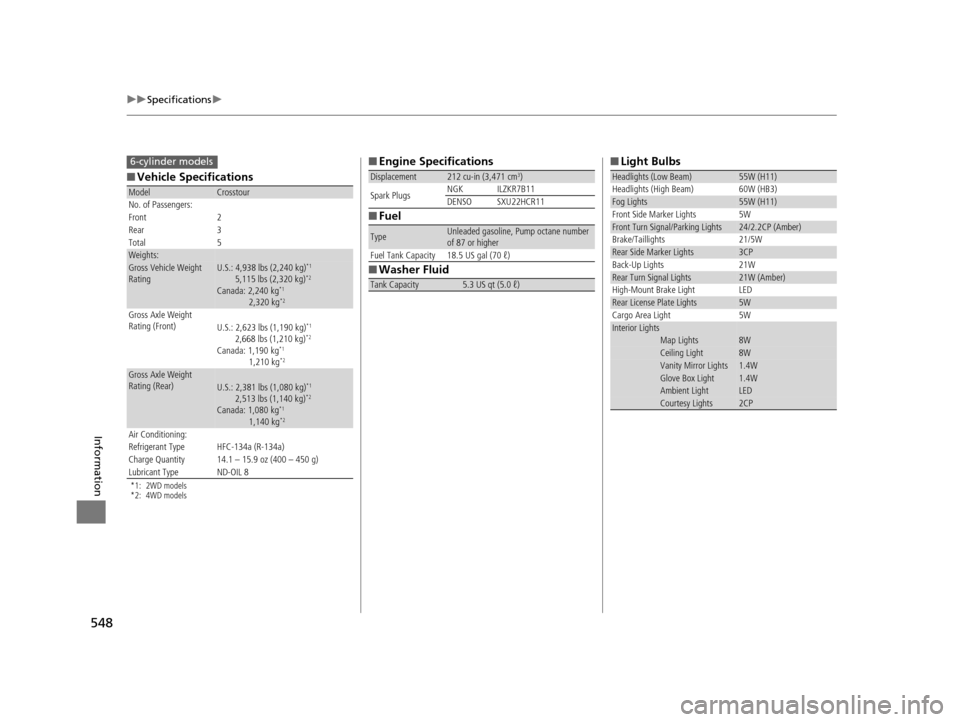
548
uuSpecifications u
Information
■Vehicle Specifications
*1: 2WD models
*2: 4WD models
ModelCrosstour
No. of Passengers:
Front 2
Rear 3
Total 5
Weights:Gross Vehicle Weight
Rating U.S.: 4,938 lbs (2,240 kg)*1
5,115 lbs (2,320 kg)*2
Canada: 2,240 kg*1
2,320 kg*2
Gross Axle Weight
Rating (Front)U.S.: 2,623 lbs (1,190 kg)*1
2,668 lbs (1,210 kg)*2
Canada: 1,190 kg*1
1,210 kg*2
Gross Axle Weight
Rating (Rear)U.S.: 2,381 lbs (1,080 kg)*1
2,513 lbs (1,140 kg)*2
Canada: 1,080 kg*1
1,140 kg*2
Air Conditioning:
Refrigerant Type HFC-134a (R-134a)
Charge Quantity 14.1 – 15.9 oz (400 – 450 g)
Lubricant Type ND-OIL 8
6-cylinder models■ Engine Specifications
■ Fuel
■ Washer Fluid
Displacement212 cu-in (3,471 cm3)
Spark Plugs NGK ILZKR7B11
DENSO SXU22HCR11
TypeUnleaded gasoline, Pump octane number
of 87 or higher
Fuel Tank Capacity 18.5 US gal (70 ℓ)
Tank Capacity5.3 US qt (5.0 ℓ)
■ Light Bulbs
Headlights (Low Beam)55W (H11)
Headlights (High Beam) 60W (HB3)
Fog Lights55W (H11)
Front Side Marker Lights 5W
Front Turn Signal/Parking Lights24/2.2CP (Amber)
Brake/Taillights 21/5W
Rear Side Marker Lights3CP
Back-Up Lights 21W
Rear Turn Signal Lights21W (Amber)
High-Mount Brake Light LED
Rear License Plate Lights5W
Cargo Area Light 5W
Interior LightsMap Lights8WCeiling Light8WVanity Mirror Lights1.4WGlove Box Light1.4WAmbient LightLEDCourtesy Lights2CP
15 CROSSTOUR-31TP66500.book 548 ページ 2014年7月31日 木曜日 午後3時23分